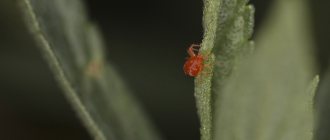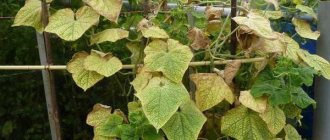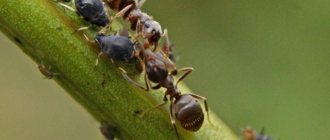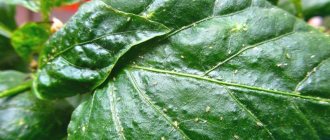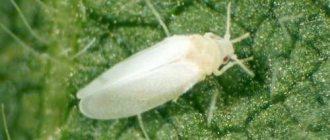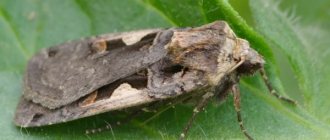Why I decided to fight whiteflies in the greenhouse
The adult whitefly can be confused with the beautiful snow-white moth. But this pretty and defenseless, at first glance, creature is a serious enemy of the gardener. The insect, like a small pump, sucks out the cell sap of various greenhouse plantings - tomatoes, cucumbers, cabbage.
The vital activity of the pest inhibits the development of plants. The seedlings stop forming green mass and do not bloom. Fruiting is unfriendly, and the harvest is small and of poor quality. When infested by whiteflies, the plant may die from a lack of nutritious cell sap.
Greenhouses are a favorable place for pests to live and reproduce: warmth, high humidity, and an abundance of lush greenery. During a 30-day life, one female manages to lay 100-150 eggs. After 20-40 days, the larvae will already turn into adult voracious butterflies.
The cubs themselves also have a good appetite. The danger of larvae is that they are invisible to the naked human eye. The length of their bodies does not exceed 0.3-0.9 mm. Like adults, they feed on cell sap. They lead a hidden lifestyle - the female lays eggs on the inner surfaces of leaf blades.
whitefly on vegetables
Reasons for appearance
This pest is attracted to high humidity and elevated temperatures. For this reason, whitefly is a frequent visitor to greenhouses. The whitefly feels comfortable in the greenhouse at any time of the year. At a temperature of -10 degrees, this pest dies, but the eggs do not die and can remain in this state for a long time, waiting for comfortable conditions.
Insects thrive in greenhouses where there is poor ventilation and where plants are located close to each other. Improper planting of plants leads to stagnation of moisture and active reproduction of the pest.
How to understand that there is a whitefly in the greenhouse
Let me present the first signs of a white-winged pest invasion of your greenhouse:
- Inhibition of plant development, wilted, stunted appearance of plantings, brittle, weakened stems.
- Deformed foliage, sticky coating. The danger of the latter is that it becomes a favorable environment for life and the proliferation of pathogenic fungi.
- When you shake the bush, a cloud of white “moths” scatters.
Already at the first signs of a whitefly invasion, I advise you, without delaying until later, to take action against the pest. Delay threatens that you will be left without a significant part of the harvest.
Methods for controlling whiteflies in a greenhouse
I will present several effective ways to resist whiteflies, tested from my own experience. Their effectiveness depends on the stage of spread of the pest and the scale of its colonization of the greenhouse.
I recommend starting with mechanical, folk, biological, and agrotechnical methods. And only if they are useless, proceed to the use of pesticides. After harvesting, do not forget to treat the greenhouse so that overwintered pests do not encroach on future plantings.
Removing whiteflies mechanically
The easiest and safest way to control white-winged pests is manual collection. To make your work easier, I recommend using the instructions:
- Give your greenhouse plants a “bath day”: attach a spray nozzle to the hose and water the plants using the drip method. Direct the stream at the leaves and stems to wash the adults to the ground. I advise you to hold the shoots and foliage with your hands so as not to accidentally damage them.
- Dilute the soap solution: 100 g of fine shavings of tar or laundry soap per 0.5 liters of water.
- Arm yourself with rubber gloves and a sponge. Dipping a washcloth into the soapy solution, thoroughly rinse the stems and leaves on both sides. This way you will rid the plant of eggs, larvae, and harmful sticky plaque.
- As soon as it gets dirty, change the soap solution to a new one - this will make cleaning more effective.
The method is quite painstaking, but effective: if you have a small number of plantings in the greenhouse, in one procedure you can kill the voracious butterfly forever.
Biological method
Many resourceful gardeners do not spend their own energy fighting the pest - they prefer to leave this task to the natural enemies of the whitefly. Its most formidable opponent is Encarsia Formosa. This is the so-called “parasitic rider”. Encarsia females lay their eggs in whitefly larvae. From this, the latter quickly die.
Parasitic parasites are not common in the garden like chafers or ladybugs. You will have to purchase special test tubes, capsules with encarsia larvae. They are available both in garden centers and online stores.
The “consumption” of the natural enemy is very economical: one individual is required per 1 m2 of greenhouse. You should not be afraid of the spread of encarsia throughout the area: after the destruction of the whitefly in the greenhouse, the parasite will die, as it will lose its natural nutrition.
Agrotechnical means
You can fight whiteflies by planting plants in the greenhouse that the insect somehow does not like:
- tobacco;
- garlic;
- dandelion.
Don't forget about the natural enemies of voracious butterflies - ladybugs and lacewings. To attract insects, open the greenhouse windows and doors on a nice day. Ladybugs can be carefully collected in a box on your site and released in a greenhouse.
Chemical control agents
If you cannot cope with the whitefly using safe and readily available methods, it makes sense to turn to insecticides:
- "Spark";
- "Aktellik";
- "Aliot";
- "Biotlin";
- "Cypermethrin";
- "Neudosan";
- "Fufanon";
- "Alatar";
- "Confidor";
- "Malathion";
- "Aktara" and so on.
All the variety of chemical preparations are used according to a similar method: according to the instructions, a suspension of the required concentration is diluted, the liquid is poured into the barrel of the sprayer, and then the tops of the plants are irrigated with the solution. After processing, be sure to maintain the specified waiting period - it is unsafe to harvest the crop earlier and eat the fruits.
Remember that you will have to work indoors without access to fresh air. Therefore, you must have closed clothing and shoes, a hat, a respirator, safety glasses and rubber gloves.
Traditional methods and recipes
I will share with you effective non-standard methods that will help remove whiteflies from the greenhouse. I also recommend contacting them in cases where the butterfly invasion occurred during fruiting. It is not safe to use chemicals at this stage.
Fumigators
These are special devices designed to combat annoying mosquitoes and flies. A capsule is inserted into the device, a plate soaked in repellent emulsion is plugged into the network.
The only difficulty is running an electrical extension cable to the greenhouse. Close the windows, doors, and ventilators tightly, and then turn on the device. A few hours of work is enough for all the whiteflies inside to die. However, the beneficial insects inhabiting the greenhouse will also die along with them.
Herbal infusions
Let me present an effective “grandfather’s” recipe for a remedy made from yarrow:
- Collect the plant during the flowering period, dry it, and grind the dry mass.
- Fill a 10-liter bucket ¼ full with grass. Add the rest of the volume with water.
- Close the lid and leave in a warm place for 2-3 days.
- Strain the liquid and apply it to the plantings from the sprayer.
- For prevention, repeat treatment every 1-2 weeks.
The second effective infusion is garlic. It also has a bactericidal effect - it will help neutralize pathogenic fungi that multiply in the sticky waste of whiteflies:
- Pound and chop the garlic heads - you should get 1 cup of aromatic mass.
- Pour 10 liters of heated water over the garlic.
- Leave the mixture for 2 days, strain when ready.
- Use a spray bottle to spray each leaf of the affected plant on both sides.
- Repeat the treatment after 4-5 days until the pest is completely destroyed.
Another effective infusion is from dandelion:
- Grind 50 g of rhizomes and 50 g of green mass (without flowers) of the plant.
- Pour in 1 liter of water.
- Let it brew for 2 days.
- Strain and spray the plants with dandelion solution.
- After 2 weeks, repeat the treatment.
It is also effective to dust affected plants with tobacco dust and prepare liquid solutions based on it.
Sticky traps
Another fly repellent that helps effectively eliminate whiteflies. A little secret: buy yellow adhesive tapes - it attracts pests more than others. It is possible to make such a trap yourself: cut cardboard or yellow plywood into pieces, ribbons, paint them with yellow gouache and a felt-tip pen.
Then cover the surface on both sides with a sticky substance - honey, sugar syrup, preserves, jam, petroleum jelly, rosin. You can use special glue against rodents. Make holes in each of the traps and pass twine or string through them. Tie to supports above plants, structures on the roof of the greenhouse.
In the future, all that remains is to remove the traps with adhering pests, replace them with new ones, or simply clean them off and renew the adhesive layer. The adherence of whiteflies can be facilitated: periodically shake the greenhouse plants - disturbed insects will look for a new location and rush to the inviting yellow color.
Greenhouse (greenhouse) treatment
If chemicals do not help, the last resort is to use a sulfur bomb. But the method is good only after harvesting. It has many disadvantages: it causes corrosion of metal structures, destroys all living things in the greenhouse, including beneficial soil microorganisms.
After sulfur treatment, I recommend removing the top layer of contaminated soil - pest larvae may remain in it. It would not be a bad idea to use a checker in the fall if during the season the greenhouse plants were attacked by whiteflies.
Prevention of whiteflies in a greenhouse
In order not to waste time and energy on confronting the voracious “moth”, it is best to prevent its spread in your area. This is easy to do by turning to effective prevention:
- Collect and destroy all plant waste remaining after the end of the season. Especially from sick plantings affected by pests.
- In late autumn, before the onset of serious frosts, dig the soil deeply (on the bayonet of a shovel).
- Every autumn, disinfect the greenhouse: treat not only the soil, but also the internal surfaces, cracks and all kinds of openings where pests can overwinter. Use Bordeaux mixture, bleach solution, potassium permanganate.
- If possible, periodically ventilate the greenhouse in winter - open the windows and doors wide open. Another option is to completely remove the frame for the winter and let the greenhouse soil freeze.
In comfortable greenhouse conditions, a serious enemy of gardeners, the whitefly, can easily establish itself. The butterfly and its larvae suck out cell sap in huge volumes, which leads to a decrease in yield and even death of plants. But now you know a lot of effective ways to counter the winged pest. Be sure to take note of simple ways to prevent the appearance of whiteflies.
How to get rid of whiteflies on indoor plants
The most effective way to get rid of whiteflies at home is a combination of several methods:
- Wash each plant by hand with soap to remove pests, after wrapping the pot in a bag so as not to wash out the soil.
- Thoroughly rinse off all remaining soap and let the plant dry.
- Apply to the plant and add to the soil a special product for exterminating pests of indoor plants; a spray or aerosol such as Bona Forte, Tsvetolyuks, Aktara, Doctor or their analogues are suitable.
In case of mass infection, transplant the plants into new, clean pots with fresh, disinfected soil. Whiteflies always fly indoors from the street, so in the summer it makes sense to install protective nets on the windows. This will help avoid problems not only with whiteflies, but also with a host of other pests.


